
The Arabian camel is an animal that belongs to the camel family. It lives in the desert and is generally known as the dromedary. It is nicknamed the 'Ship of the Desert' by Arabs, due to its ability to withstand long periods of heat and thirst, which can last up to a month in cold weather conditions. Female camels are locally known as 'Naqa ' in Arabic, while the plural form is ' Nuq. ' The male camels, on the other hand, are known as ' Ba'eer ' in s...
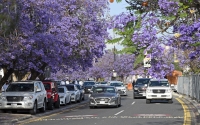
The Jacaranda tree in Saudi Arabia is a beautiful flowering tree that belongs to the Bignoniaceae family. People intentionally grow it all over the country for its ability to provide shade and its ornamental value in gardens, public squares, and streets. The people in Aseer Province, located in the southern part of Saudi Arabia, especially in Abha, are particularly well-known for cultivating Jacaranda trees, with over fourteen thousand trees in the city alone. It originates from the tropical re...
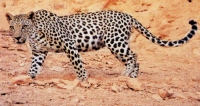
The Arabian leopard lives high in the mountains and is distinguished from leopards worldwide by its small size and light color. It is classified as a species found exclusively in the Arabian Peninsula. The Arabian Leopard appeared in Africa around five hundred thousand years ago, and its drawings were found inside a cave in the Shuwaymis region, southeast of the al-Ula Governorate in the al-Madinah al-Munawwarah in the Kingdom of Saudi Arabia. It is considered a carnivorous mammal belonging to ...
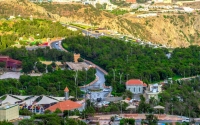
Forests in the Kingdom of Saudi Arabia cover an area of more than 2.7 million ha of land, with varying densities and vegetation types. These forests are distributed in several locations, including the forests of Sarawat Mountains, Shura forests on the Red Sea and the Arabian Gulf coast, in addition to some forest sites with diverse vegetation around valley streams, rivers, basins, and reefs throughout Saudi Arabia. According to the Ministry of Environment, Water and Agriculture, the highlands o...

In the deserts of the Kingdom of Saudi Arabia, several species of animals inhabit, including the Arabian Oryx, Mountain Gazelle, goitered gazelle, ostriches, hares, Arabian wolves, hyenas, sand cats, hyrax, chlamydotis, eagles, partridge, and pterocles. These animals inhabit wildlife reserves covering an area of 82,700 km² in the Kingdom. Some of these reserves have been designated as royal reserves to conserve the wildlife and vegetation within them. The Council of Royal Reserves was establis...

The Environment of the Kingdom of Saudi Arabia encompasses everything surrounding humans, animals, plants, or any living organisms, including water, air, land, soil, living beings, biodiversity, atmospheric gases, water bodies, and all that these mediums contain in terms of inanimate objects, various forms of energy, habitats, and natural processes and their interactions. The Kingdom works to preserve, protect, develop, and prevent the pollution of the environment, in accordance with Article Th...
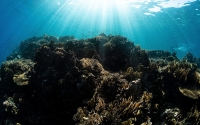
The Saudi Geological Survey has estimated that the Kingdom of Saudi Arabia is home to two hundred types of coral reefs which are located on the Red Sea, in different colors and shapes. The Arabian Gulf coasts include around sixty species of coral reefs called al-Fushut, al-Kitaa', al-Qassar, and al-Halat, according to their composition and size. Some of them take the form of barriers, while others look like bays. Coral reefs are found in large areas on the Kingdom's coasts in the Red ...
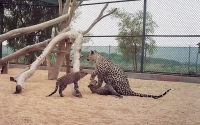
The Arabian leopard is a carnivorous mammal belonging to the Felidae family and is an endangered species. AlUla Province in the Kingdom of Saudi Arabia has been an ancient habitat throughout history for the Arabian Leopard. It was also seen in the highlands of the Aseer Province . The Arabian Leopard lives in high mountains and remote areas far from human settlements, and it does not attack humans unless provoked. It is one of the rarest wild animals in Saudi Arabia and globally, according to t...

Environmental protection in the Kingdom of Saudi Arabia refers to the ecosystems and methods used by relevant entities to support the preservation of the environment and its balance in the Kingdom. The General Environmental Regulation, issued in 2001, defined the protection of the environment as the preservation of the environment, and the prevention and reduction of its pollution and degradation. To protect the environment and preserve wildlife, the Kingdom has issued a number of laws and legi...
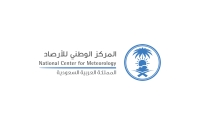
The Cloud Seeding Program in the Kingdom of Saudi Arabia is a technology that aims to stimulate rainfall of some types of clouds by changing some of their physical features and increasing the rates and quality of rainfall over some pre-specified regions. This program aims at increasing rainfall in the Kingdom by 20 percent. The Council of Ministers approved the program on February 11, 2020, with its execution being supervised by the Ministry of Environment, Water, and Agriculture. Special aircr...

Aseer National Park is a national park located in as-Sudah Center in Aseer province, Kingdom of Saudi Arabia. It spans an area of approximately 4,500 km². It was established with the goal of utilizing its green spaces to rehabilitate wildlife in the province, including rare plants, endangered species, birds, and animals. The construction cost of the park amounted to about SAR58 million. Preparation of studies and designs for the park began in 1976, and it opened its doors to visitors in 1980. ...

Camel Breeding in the Kingdom of Saudi Arabia was one of the vital aspects of the lifestyle culture for most of the population in the past. It is one of the occupations practiced by Saudis and passed through generations until the present day. Scientifically speaking, camels are domesticated herbivore mammals raised in the Kingdom in groups, either in the wild or in equipped shelters with walls for trading, domestication, and benefiting from their meat, milk, and fur. Camels have crucial economi...